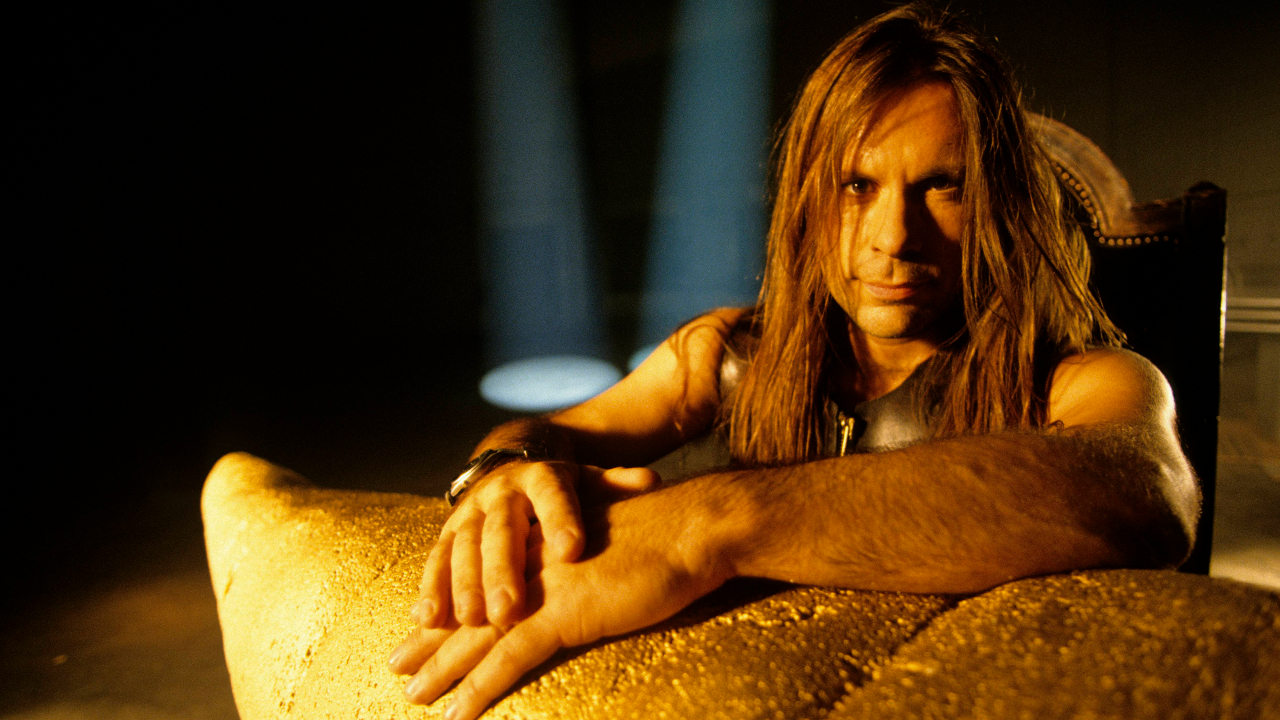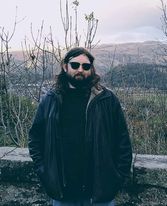“I had no idea it would be such a catastrophic event in people’s lives!" How leaving Iron Maiden, A Nightmare On Elm Street and the acoustic album that never was led Bruce Dickinson to write Tears Of The Dragon
Tasked with kicking his solo career off for real, Bruce Dickinson produced one of the 90s' greatest metal power ballads

Bruce Dickinson hadn’t planned on going solo. Frontman for Iron Maiden since late 1981, it certainly wasn’t like his day job wasn’t fulfilling – or demanding – enough. But during a rare Maiden break in 1989, he was approached by publishing company Zomba to provide a song for the soundtrack to the fifth Nightmare On Elm Street movie. The song, Bring Your Daughter To The Slaughter would ultimately be re-recorded by Iron Maiden in 1990 and became the first metal song to top the UK singles charts.
“It was all by accident!” Bruce attests with the amiable dismissiveness of someone used to tripping and landing in gold mines. “A guy from Colombia records heard it and was like, ‘Oh my god, I love that song! Do you have more like it?’ So I lied and went ‘Oh yeah, loads.’ Suddenly, I had an American record deal for an album we hadn’t even written!”
Bruce was hardly agonising about writing, though. Bring Your Daughter... had been written “in about five minutes” by Bruce and soon-to-be Maiden guitarist Janick Gers, so the pair teamed up again to rapidly write the material that would become 1990’s Tattooed Millionaire. Bruce’s first solo effort, the record was good times rock’n’roll in the vein of AC/DC with a dash of Led Zeppelin chucked in for good measure. It was a big departure from the theatrical bombast of Maiden, but still broke the top 20 in the UK Albums Chart.
“Everything was sweet,” Bruce recalls. “But then, it was time for the next album. The problem was, now I had to think about what I’d really do on a solo record. Because [Tattooed…] wasn’t really a solo album. If I died and people went, ‘The last thing he did on this Earth was Tattooed Millionaire,’ I’d be like, ‘No, no, no!’ It was just a bit of fun, I wanted something with a bit more weight to it emotionally.”
There was certainly no shortage of emotion to draw from. In 1993, Bruce announced he planned to leave Iron Maiden to focus on his solo career full-time. In turn, that meant his solo work had gone from something fun he did between Maiden tours to his main artistic output. But where his previous solo work had been almost effortless, album two was a tortured process as he tried to figure out what he wanted to be.
First, Bruce hooked up with guitarist Myke Gray of British rockers Skin. Bruce had already worked with Skin for a cover of Alice Cooper’s Elected in 1992, which also featured comedian Rowan Atkinson as Mr. Bean and had broken the UK top 10 singles when released as part of charity Comic Relief. Unfortunately, they weren’t able to replicate that success while writing together. “Myke is very talented,” Bruce says. “But I realised he was very much in metal world. Which is great, but I wanted to sidestep some of that and go outside it while still being heavy.”
Scrapping those sessions, the next suggestion came from longtime manager Rod Smallwood, who suggested he work with producer Keith Olsen. “Keith had reinvented David Coverdale and turned him into the image of this big American radio artist,” Bruce recalls. “He sounded a little bit like Led Zeppelin and didn’t sound like the David Coverdale I’d loved with [early] Whitesnake. So I was a little sceptical. It was like, ‘I know it’s working, but it ain’t Walking In The Shadow Of The Blues.’”
Sign up below to get the latest from Metal Hammer, plus exclusive special offers, direct to your inbox!
Heading out to LA, Bruce found himself working with session musicians for the first time to achieve a vision of something that could be heavy without feeling too obviously indebted to metal. “One of my favourite albums is Peter Gabriel’s third solo album [aka Melt],” Bruce explains. “Emotionally, it’s so dark and heavy, and I thought, ‘Can I get that level of heaviness?’ We kicked out the heavy metal cliches and the crass stuff because I’d done it all.”
Unsatisfied with the result, Bruce scrapped the sessions for a second time. The LA trip wasn’t a total bust, though. The engineer at Olsen’s studio – and eventual producer of Balls To Picasso – Shay Baby suggested that while Bruce was in town, he should go check out the band Tribe Of Gypsies, featuring guitarist Roy Z. Blown away by their performance, Bruce had finally found his new co-conspirator.
“I was chatting to Roy at Shay’s house one afternoon and we knocked out the basis for three or four songs right there,” he recalls.
One of the songs that Bruce and Roy worked on had actually existed for the better part of a decade. After Maiden had released Powerslave in 1984, Bruce had suggested to the band they do something completely leftfield for their next release; an acoustic album. The suggestion went down like a lead balloon. “Look, that’s not what Maiden does,” Bruce says diplomatically. “We do the unexpected, but roughly in the same direction.”
The first version of Tears… Bruce describes as “Jethro Tull-y and a bit witchy-woo”, written around Powerslave. A second version was written while Bruce was working with Keith Olsen, which he describes as “very dark, all keyboards and sequencers, stuff like that”. But the final, released version of Tears Of The Dragon felt more like connective tissue to Bruce’s tenure in Maiden: a grand epic with twists and turns that, in part at least, proved a little divisive.
“The reggae bit in the middle – for some reason I can never quite figure out – is ‘controversial’,” Bruce concedes with a grin. “Rod [Smallwood] was like, ‘Eugh! Get rid of that fucking reggae thing.’ But we kept it in and still play that live. It’s cool and different, it takes us somewhere else, like a dream world. It’s a palette cleanser after the insanity of everything that’s gone before. I love it.”
The first single from Balls To Picasso, Tears Of The Dragon was also Bruce’s first release since he’d officially left Maiden. Naturally, people assumed the song was about his departure.
“It’s a bit deeper than that,” Bruce contests. “Farewell to Maiden sounds like I was thumbing my nose at them. It was more introspective; it’s about self-doubt. I had a lot of that. When I embarked upon the solo album thing, I really didn’t have a clear idea of what I was doing. Creatively, I just felt lost. I found that really disturbing. It worried me that being in Maiden had maybe disabled some of my critical faculties. I was experimenting with things and it came to me, ‘Maybe I should leave – find if I have anything to give back to the world creatively.’”
While it might’ve been the best decision for Bruce creatively, not all Maiden fans were happy, feeling he’d just hamstrung one of British metal’s big success stories.
“Perhaps I was a bit naïve,” he concedes. “I had no idea [me leaving Maiden] would be such a catastrophic event in some people’s lives. I thought, ‘I’m just a singer! There’s other singers!’ My wife put it as, ‘When you left, it didn’t matter if you’d made the best record in the world. Nobody could listen to it because it was just so overwhelming that you weren’t in Maiden anymore.’”
Even so, released on May 16 1994, Tears… managed a respectable placement in the charts, hitting number 28 in the UK and 36 on the US Billboard Hot Mainstream Rock Tracks. They weren’t Maiden numbers, but it was proof enough that Bruce hadn’t thrown the baby out with the bathwater. But even after rejoining Maiden in 1999, Bruce didn’t give up his solo ambitions completely. When he resurrected his band last year for The Mandrake Project, he also decided to dust off the tapes of Balls To Picasso for a complete overhaul, titled More Balls To Picasso, naturally.
“The problem with the original version was that it was tentative,” Bruce explains. “It’s taken all these years to go, ‘Can we make this as full on as it should have been?’ It wasn’t a sin of commission, it was a sin of omission.”
Perhaps the song that benefits most from this remaster is Tears, the original single now given lush orchestration by composer Antonio Teoli. “It’s grown in stature with Antonio’s orchestration,” Bruce says. “It’s the full mango; juicy! Before it was a little more melancholy, this one has a real sense of triumph.”
‘Triumph’ certainly sums up what Bruce achieved both as a solo artist and since his return to Iron Maiden in the 21st Century.
“If I’d just stayed where I was… I’m not sure Maiden would be anything like it is now,” he admits. “I almost cut my solo career off at the knees, rejoining Maiden, because it was obvious I wouldn’t have the time to do anything with all the touring and writing we were doing. Now I’m comfortable with the Maiden situation because we’ve got this amazing theatricality going on, and the songs have become more progressive. That might not make some people happy, but that makes the band happy.”
More Balls To Picasso is out now via Sanctuary. Iron Maiden: Infinite Dreams: The Official Visual History is out now

Staff writer for Metal Hammer, Rich has never met a feature he didn't fancy, which is just as well when it comes to covering everything rock, punk and metal for both print and online, be it legendary events like Rock In Rio or Clash Of The Titans or seeking out exciting new bands like Nine Treasures, Jinjer and Sleep Token.
You must confirm your public display name before commenting
Please logout and then login again, you will then be prompted to enter your display name.

